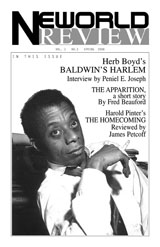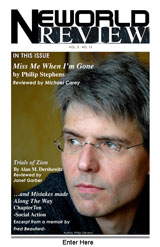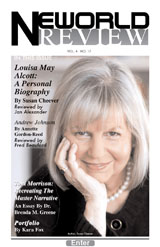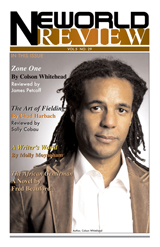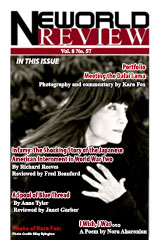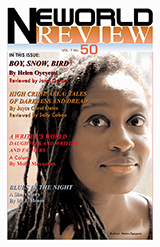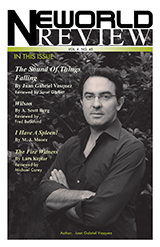Letter to the Reader:
Beware of big ideas
There is one good thing about having a photographic memory-- (the worst thing is the constant pining away over long lost, old girlfriends who once dumped you, and who have long forgotten you. I can still hear country singer, the great George Jones wailing, “He stop loving her today…. They place a wreath above his door.”)—is that you can see how big ideas play out over the years.
One of the first big ideas I remember was in the early 60s, and it was called “deinstitutionalization.” It was one of the first major Cause Celebre I followed in my maiden introduction to the fascinating world of print and ideas.
The argument the big-idea folks put forth was that by releasing the mentally ill into the “community,” the community would look after them better than trained medical workers.
According to Wikipedia, “the American psychiatrist Loren Mosher, pointed out that most deinstitutionalization in the USA took place after 1972, as a result of the availability of SSI and Social Security Disability.”
Whatever the case, soon, American cities were awash with real life zombies, and poor folks with nothing to eat, no clothes to wear, and nowhere to sleep—who were totally unable to care for themselves.
This is still with us today, with the vaunted, watchful, compassionate community nowhere in sight.
And the big-ideas folks? It was a con from the beginning. They had fooled people who thought that they were so smart and cared so much about them; and now they are safely behind large gates, with well-armed guards, totally unmindful of what is happening daily in the streets of places like New York and Los Angeles.
When I first moved to California, people of all stripes, both in the Bay Area and Los Angeles, blamed the horde of mentally-ill, homeless people now walking their once peaceful streets on Governor Ronald Reagan. But the truth was that he, like Governors all over the country, finally gave into the Cause Celebre started by the big-ideas folks.
Thanks for clicking on to us. Our numbers are soaring because of you.
Fred Beauford
Editor-in-Chief
Publisher
At an out-of-control medical center in NYC, HR manager, Melie, pleads feverishly with buttock-groping doctors and their flaky staff to just get along. But then there's a little murder, a cancer, a handsome devil and his evil parrot, a knife-wielding cook. She's not quitting until she has it all sorted out —the hunk, the macaw, her life work—and neither will you!

This Month's Articles
REVIEWING
Submission
By Michel Houellebecq
Reviewed by Robert Fleming
In the case of French maverick author, Michel Houellebecq, whose book, Submission, is the most controversial publication in the current season, and the brash amount of political satire has triggered the wrath of many segments of the European community.
This is not the garden-variety satire of Swift, Orwell, Huxley, or even Salman Rushdie’s scathing Satanic Verses, which earned him a fatwa for his disrespect of The Prophet.
Often, satire spills into the real lives of people with tragic consequences, like in Houellebecq’s case. In 2002, the writer was forced to appear in French court on charges of inciting religious and racial hatred for calling Islam “the stupidest religion” in a much-publicized interview. He was blasted for criticizing the Qur’an for its “badly written” text.
The beleaguered writer moved to Ireland, where he lived for several years.
What did Houellebecq’s Submission play in recent events involving the bloody ISIS bombings at Brussels Airport and a nearby subway station last March, killing over 35 and injuring more than 200?
His affiliation with the satirical political magazine, Charlie Hebdo, and its publication of inflammatory cartoons of Prophet Mohammed in 2006. put his life in danger. Five years later, its offices were firebombed after an issue was supposedly guest-edited by the Prophet.
Last year, the European edition of Submission was featured on the cover of the Charlie Hebdo, and the fallout was lethal on January, 2015, when a group of masked gunmen attacked the magazine’s Paris office, shouting “Allahu Akbar,” slaughtering twelve people and injuring many others.
Critics called Houellebecq’s work “Islamophobic scaremongering.” The country, and all of Europe, was frightened of the savage series of terrorist attacks, compounded by the influx of immigrants pouring in from ravaged Middle East countries.
At the moment of the attack, Submission publisher William Heinemann bought the book from the French publisher Flammarion, which stationed more security around its facilities after the book’s release. Freedom of expression had been trumped by strict religious dogma, terrifying all infidels.
Currently, the world is in an uproar, waiting on edge to see where the Jihadists will strike next. Houellebecq’s latest novel, Submission, feeds into the paranoia, generating heated debate about Islam and terrorism, multiculturalism and nationalism, freedom of expression and extremism.
It tells the tale of Francois, a 41-year-old professor of literature and an expert of lusty J. K. Huysmans, a seducer of perky teen flesh. In some sense, Francois is Houellebecq, commenting on the state of middle-aged masculinity, the future of marriage and family and the rights of the individual in an increasingly regulated society.
Submission’s plot runs a parallel track between the emotionally stilted quest of Francois and an imagined France in the election year of 2022, with the surging racist National Front....Read More
REVIEWING
Spain in Our Hearts: Americans in the Spanish Civil War, 1936-1939
By Adam Hochschild
Hell and Good Company: The Spanish Civil War and the World it Made
By Richard Rhodes
Reviewed by Michael Moreau
The War in Spain Still Inspires
A few weeks ago The New York Times published a moving op-ed tribute titled “The Good Soldier,” an homage to Delmer Berg, for whom the paper had recently run an obituary. Berg was the last known living member of the Abraham Lincoln Brigade, one of about 2,800 Americans who had volunteered to fight against the fascists in the Spanish Civil War of the mid-1930s. He was also a life-long Communist.
The tribute surprisingly was written by Senator John McCain of Arizona, who said of Berg and his comrades in arms, “I have always harbored admiration for their courage and sacrifice in Spain.”
Berg, McCain went on to say, “didn’t need to know for whom the bell tolls. He knew it tolled for him. And I salute him. Rest in peace.”
The senator’s reverential words from one warrior to another followed close after the publication of two masterful new books on the Spanish Civil War, Spain in Our Hearts by Adam Hochschild and Hell and Good Company by Richard Rhodes.
Hochschild, a founder of Mother Jones Magazine and author of the highly praised King Leopold’s Ghost, among other books, has perhaps crafted the more magisterial of the two entries in the crowded field of books on the topic, perhaps because he casts a wider net than Rhodes, whose intent is to focus on the technology of a war that was in many ways a testing ground for wars to come.
Hochschild covers the whole scope of the war with particular emphasis on the writers who engaged in it—and most particularly George Orwell and Ernest Hemingway, who both reported on the Spanish conflict and immortalized it in Orwell’s Homage to Catalonia and in fiction, Hemingway’s For Whom the Bell Tolls, the book that may be all that most people know of the war that was the prelude to and was overshadowed by World War II.
Hochschild says he was introduced to the war in the mid-1960s by two older colleagues a....Read More
NOVELLA
A History of The 21st Century
A Memoir By Major Alexander Pushkin Litvinova, U.S. Army, ret.
A Novella by Fred Beauford
Chapter 10
This was a terrible time for me, Father. The Rev. Guess years are still a big blur. I remember little, only noticing now and then, the passing of yet another restricted law.
Women were quickly tossed out of the military. Gay marriages were banned. People who got caught even carrying as much as one joint, were thrown in jail for years.
The clerics had taken over. Rev. Guess’ entire cabinet was one big congregation of religious leaders.
Father, you wouldn’t have recognized this America! For the first time in our history, we had more people leaving than coming in. No one with good sense wanted to come to America, which was just fine with Rev. Guess and his boys.
Along with gays, and women not staying home and raising their kids, and having the right to murder the unborn, they laid much of the blame for America’s fall from grace on the corruption of “foreign influence.”
Soon, the sneering stopped. The rest of the world started getting very nervous. Rev. Guess was no longer a comic figure to be snickered at, but was gaining by the day, more and more power, and was armed to the teeth with nukes and the best military hardware in the world. The world knew that America was on a hair-trigger and one false move by anyone meant a sure attack.
But I could have cared less by all the politics. I had gradually withdrawn into a harden shell, which became harder, and harder until I totally withdrew from the world. Politics had become vague, although I knew instinctively that I was living in a world now more dangerous than anything that you could have imagined, Father.
Still, I didn’t care what happened to the world. Let them all die, like my friends had died! I just walked the beach unshaven, often talking out loud to Mother, and David, and Gina, and my leader, Colonel Bird.
I hung on for dear life to Mother’s apartment. I supported myself mainly from my pension from my Army service. Rev. Guess was smart enough not to piss off us Vets. In fact, he even increased the amount of money we received.
He even went on the air and made the announcement. This is what he said to the nation. And this is the last....Read More
<REVIEWING
Forty Years Stoned: A Journalist’s Romance
By Tom Huth
Reviewed by M. J. Moore
Confession: I’m one of those readers who have developed an allergy regarding most Baby Boomer clichés. Like so many others, I’m tired of hearing about where they were when JFK was gunned down or how the Beatles changed their lives or why they did or did not go to San Francisco and wear flowers in their hair.
However, Forty Years Stoned, a memoir penned by former Washington Post staff writer Tom Huth, is a story so riveting and in some ways so unique that even though certain Boomer-centric milestones are repeated, the book is not stale.
Contrarily, due to the vibrant spirit of the author and also the exceedingly offbeat tale he has to tell, this memoir is nothing less than a heartbreaking delight. And if “heartbreaking delight” qualifies as a hefty oxymoron, a closer look is justified.
Right off the bat, Tom Huth’s narrative clarifies that he is actually a pre-Boomer. This is important. A vast number of books, movies, TV shows, and hit songs have focused on the lives and times of individual protagonists who were born between 1946 and 1955 (the first decade after the end of World War Two).
What this book convincingly establishes is how important a mere half-decade can be. Author Tom Huth was born in 1942. He anchors his narrative to the year 1972 as a starting point for myriad life changes that affected him after the 1960s ended.
As the author puts it, with admirable succinctness: “I have just turned thirty. I am married to my college girlfriend from my hometown of Detroit. Carol and I are two middle-class kids pretending to be grown-ups. We are good friends but intimacy has eluded us. We live with our two children…I am sporting a big Jerry Rubin beard to let my editors, and everyone else, know where I stand.”
For the record: Jerry Rubin was both a famous and infamous radical activist with wildfire Hendrix hair and a bushy beard, known mostly for his wide television exposure regarding the 1968 protests at the Democratic National Convention in Chicago, and the subsequent trial of the Chicago 7. Once upon a time, Rubin was lionized by the New Left and a portion of America’s youth; later in life, before he died, he’d converted to Yuppie culture and a career in finance. Now he’s a footnote.
But it’s crucial in this memoir for Tom Huth to pinpoint the cultural signposts that buoy one of his key observations:
“When the 1960s broke out, there were lots of young people my age—the war babies, the pre-boomers—who were caught in the middle. The civil-rights and free-speech movements exploded just after I’d finished college and gotten married and started a career and had a child, all....Read More
MEMOIR
JUST SAY YES: A Marijuana Memoir
By Catherine Hiller
Reviewed by M. J. Moore
If one of the most impressive aspects of Tom Huth’s Forty Years Stoned is its clean and controlled use of chronological order (his narrative moves smoothly from past to present), then equally impressive is the daring, innovative use of reverse chronological order in Catherine Hiller’s Just Say Yes: A Marijuana Memoir.
No less impressive is the wide-ranging list of social issues, family tensions, academic strides, cultural convulsions, and varied coming-of-age episodes that Catherine Hiller deploys, all the while sharing anecdotes both startling and thoughtful.
Tom Huth qualifies as a pre-Boomer, who feels that he was just a little too old to partake of the 1960s with gusto. But Catherine Hiller? She brands herself as a dyed-in-the-denim, on-time Boomer who didn’t just hear about Woodstock in 1969; nor did she merely buy the album or see the film in 1970. Hiller was actually there.
What makes her memoir important is that her writing is switchblade sharp (don’t take my word for it, take John Updike’s verdict: “good, brave, and joyful writing” is how he lauded her). But even more important is that Hiller has something to say.
Just Say Yes deserves to be on the same shelf as Pete Hamill’s A Drinking Life or Jack London’s John Barleycorn; or Alcoholic Memoirs. And yet, here’s the cautionary note.
Unlike so many authors who have chronicled their lifetime of patterns with hard habits to break, Catherine Hiller does not, in the end, convert and become a 12-stepper or a sober zealot or an advocate for abandoning one’s love of weed.
Instead, while writing with the anecdotal zest of Pete Hamill and the narrative punch of Jack London combined, there emerges from this memoir a sense of awareness, contentment, relentless humor, and bruising honesty about the ups and downs of being a lifelong marijuana acolyte. For Hiller, no intervention is required.
Despite the hassles and occasional capers involving dealers, colleagues, traffic cops, annoyed family members, airport security types or irritating social prohibitions, Hiller’s biographical note at the back of the book assures us: “She has smoked marijuana almost every day for the past fifty years.”
And what does she have to say? Here’s a representative sample: “Some people like to run or bike when they’re stoned, but I don’t like to be physically active. Smoking makes me languorous....Read More
ARCHITECTURE
The History of the Barclay Hotel
By J. M. Moore
Reviewed by Jane M McCabe
During the late 19th Century and early 20th Century, across the United States, in towns large and small there was a dramatic upsurge in the construction of magnificent buildings, particularly in the downtown sections, fueled by the profits made from the oil, mining, farming and transportation industries and the millionaires that it had produced, millionaires who wanted to show off their wealth and enjoy the comforts of these fine buildings.
Los Angeles, which was seeing the beginning of the rapid growth that caused it to become the second most populous area in the country, had more than its fair share of such men and, therefore, a high concentration of such buildings that were built downtown, building such as, to name just a few, the Bradbury Building at 3rd Street and Main—the Italian Renaissance Revival building built by Lewis L. Bradbury in 1893, the Biltmore Hotel—constructed between 1921 and 1923, and the Barclay Hotel, built by Isaac Newton Van Nuys, a wealthy farmer, banker and businessman, which opened its doors on January 19th, 1897, nearly 120 years ago.
This six-storied hotel was the epitome of the luxury and style for its time—32 rooms on each floor, making a total of 160 rooms, lavishly decorated with ornate furniture and plush carpets, offices, parlors, a dining room, a grill and kitchen on the ground floor, exquisite silver flatware and fine china used in the dining room, the Romandy’s Orchestra to serenade diners, and electricity and telephone service in every room. The then-popular Beaux-Arts architectural style inspired Greek and Roman elements—columns and high ceilings—stained glass, and arched doorways. It was built mostly from brick and stone, thus making it fire proof (however, there were fires in 1972 and 1974.)
The history of the Barclay Hotel (formerly called the Van Nuys Hotel) is one of happiness and tragedy, for over the course of its many years, almost anyone who was someone stayed there, but there were also horrific accidents, murders and suicides, which took the lives of some residents and causing others to call it, “a place where people come to die,” and so adding to the lore of Los Angeles’ dark history.
All of these historic treasures in downtown Los Angeles have stories to tell and perhaps ghosts that inhabit their quarters, complaining of the untimely deaths they suffered, but the Barclay Hotel has found....Read More
REVIEWING
Bowling in an Abaya: an American Teacher’s Memoir from Yemen
By Marisa G. Garcia
Reviewed by Jane M McCabe
I read travel books the way others watch The Game of Thrones, particularly those written by authors who have traveled to the Middle East. And, so, when I noticed a young woman sitting at the Greater Los Angeles Writers’ Society booth at the recent Los Angeles Times Book Festival at the University of Southern California in Los Angeles (a yearly event held every April) holding a book by this title, Bowling in an Abaya, I was drawn to her.
Ms. Garcia is a pretty Latina lady (her roots are Puerto Rican) with an open face and a lively spirit. Soon enough we fell into talking about the excessive use of khat, a narcotic that is chewed by both men and women in Yemen. I knew about this from another book I had read on the region. When I offered to review her book for this magazine, she handed me a copy.
Yemen is at the southern end of the Arabian Peninsula, bordered to the north by Saudi Arabia, the Red Sea to the west, the Gulf of Aden and the Arabian Sea to the south, and Oman to the East. Most notable is that was the home of the Sabaeans; so, Queen of Sheba, who came bearing gifts to King Solomon in the 10th Century BC, came from Yemen. Its capital was Sana’a but now, since Sana’a has come since 2015 under rebel control, it has been moved to Aden.
Yemen is one of those Middle Eastern countries whose politics I find impossible to follow. It was a British protectorate after the Middle East was carved up following WWI until 1967, when it became a kleptocracy, “a government by those who seek chiefly status and personal gain at the expense of the governed.”
Yemen has been in a state of political turmoil since 2011, when its President Salah stepped down. It has affiliations with Al-Qaeda, particularly in the north. Recently, Saudi Arabia bombed area of the country but I don’t know why. I can’t even say whether Yemen is Sunni or Shiite, but I know it’s a country of religious extremism, not a particularly inviting place for a spirited young American woman such as Ms. Garcia.
After a decade working in advertising, Ms. Garcia transitioned into education. She realized the global appeal and travel opportunities for English teachers so she applied to teach overseas. In 2007 and was given an assignment in Yemen. She was situated in Aden, Yemen’s second largest city, a small seaport city situated in the southernmost tip of the country.
Ms. Garcia spent about six months there. Her good natured account of her oft-times lonely and frustrating experience, of the claustrophobic and secluded world of Yemeni women, did not increase my desire to visit Yemen. I didn’t realize until reading her book the degree to which a strict Islamic code restricts their lives: they cannot leave their home without....Read More
REVIEWING
Where’s the Next Shelter?
By Gary Sizer
Reviewed by Michael Carey
What happens when you decide you are done with your office job and you are going to go on a five-month hike through the wilderness? Gary Sizer did just that, and Where’s the Next Shelter? is what happened.
It is the story of his adventure along the Appalachian Trail. He starts on a “shakedown” hike where he has a run in with a black bear. The excitement continues throughout the book, from Springer Mountain, Georgia all the way to Maine.
Sizer’s first-hand account offers a unique journey for his readers. He pulls no punches in taking us from the gritty lows of giardia and Lyme’s disease through the terrifying experience of a windstorm in the White Mountains to the heights of the final summit at Mount Katahdin. Each hiker has their own experience out there in the woods, but Sizer excels at bringing the trail culture to the reader while weaving in his personal experience.
His love for the outdoors is apparent from the start. Sizer (given the trail name Green Giant) teaches us about the flora, the fauna, Camping 101, trail etiquette, and the indomitable human spirit. Where’s the Next Shelter? shines as an account of real relationships and real challenges ....Read More
Neworld Review
Vol. 9 No 65 - 2016
Editor-in-Chief
/Publisher
Fred Beauford
Online Managing Editor
Richard D. O'Brien
Associate Editor
Jane M. McCabe
Fiction Editor
Jan Alexander
Poetry Editor
Sally Cobau
Senior Editors
Molly Moynahan
Herb Boyd
M.J. Moore
Janet Garber
Director of Photography
Kara Fox
President
Alexis Beauford
Contributing Writers
Michael Carey
Robert Fleming
Steve Fisch: Portfolio
Emily Rosen
Jane Smiley
Michael Moreau
Steve Fisch: Portfolio
Robert Fleming
Michael J. Moore
The Neworld Review is a publication of Fred Beauford, 3183 Wilshire Blvd,
Suite 196,
Los Angeles, CA. 90010.
Material in this publication may not be reproduced in whole or in part without permission. Opinions expressed by contributors do not necessarily reflect the views of the publishers.
Manuscripts should be accompanied by a self-stamped envelope. Online submissions are accepted at [email protected].
Neworld Review cannot be held responsible for unsolicited photographs or manuscripts.
All correspondence to:
Fred Beauford
Editor-in Chief/Publisher
Neworld Review
3183 Wilshire Blvd,
Suite 196,
Los Angeles, CA. 90010
Archived Issues


